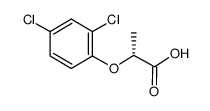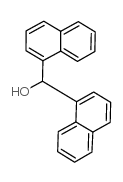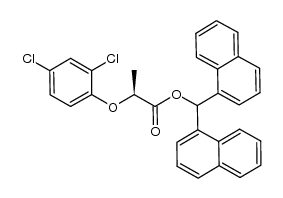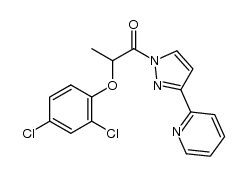(R)-2-(2,4-Dichlorophenoxy)propanoic acid

(R)-2-(2,4-Dichlorophenoxy)propanoic acid structure
|
Common Name | (R)-2-(2,4-Dichlorophenoxy)propanoic acid | ||
|---|---|---|---|---|
| CAS Number | 15165-67-0 | Molecular Weight | 235.06400 | |
| Density | 1.421g/cm3 | Boiling Point | 348.3ºC at 760mmHg | |
| Molecular Formula | C9H8Cl2O3 | Melting Point | 124° | |
| MSDS | Chinese USA | Flash Point | 164.5ºC | |
| Symbol |


GHS05, GHS07 |
Signal Word | Danger | |
| Name | (R)-dichlorprop |
|---|---|
| Synonym | More Synonyms |
| Density | 1.421g/cm3 |
|---|---|
| Boiling Point | 348.3ºC at 760mmHg |
| Melting Point | 124° |
| Molecular Formula | C9H8Cl2O3 |
| Molecular Weight | 235.06400 |
| Flash Point | 164.5ºC |
| Exact Mass | 233.98500 |
| PSA | 46.53000 |
| LogP | 2.84530 |
CHEMICAL IDENTIFICATION
HEALTH HAZARD DATAACUTE TOXICITY DATA
|
| Symbol |


GHS05, GHS07 |
|---|---|
| Signal Word | Danger |
| Hazard Statements | H302-H315-H317-H318 |
| Precautionary Statements | P280-P305 + P351 + P338 |
| Personal Protective Equipment | dust mask type N95 (US);Eyeshields;Faceshields;Gloves |
| Hazard Codes | Xn: Harmful; |
| Risk Phrases | R22;R38;R41;R43 |
| Safety Phrases | 24-26-37/39-36-16-36/37 |
| RIDADR | UN1648 3/PG 2 |
| RTECS | UA2458860 |
| HS Code | 2918990090 |
|
~% 
(R)-2-(2,4-Dich... CAS#:15165-67-0 |
| Literature: Analytical Chemistry, , vol. 76, # 19 p. 5837 - 5848 |
|
~% 
(R)-2-(2,4-Dich... CAS#:15165-67-0 |
| Literature: Tetrahedron, , vol. 54, # 27 p. 7883 - 7890 |
|
~%
Detail
|
| Literature: Advanced Synthesis and Catalysis, , vol. 351, # 14-15 p. 2301 - 2304 |
|
~% 
(R)-2-(2,4-Dich... CAS#:15165-67-0 |
| Literature: Chirality, , vol. 24, # 1 p. 60 - 66 |
|
~% 
(R)-2-(2,4-Dich... CAS#:15165-67-0
Detail
|
| Literature: Canadian Journal of Chemistry, , vol. 66, p. 1219 - 1222 |
| HS Code | 2918990090 |
|---|---|
| Summary | 2918990090. other carboxylic acids with additional oxygen function and their anhydrides, halides, peroxides and peroxyacids; their halogenated, sulphonated, nitrated or nitrosated derivatives. VAT:17.0%. Tax rebate rate:13.0%. . MFN tariff:6.5%. General tariff:30.0% |
|
The role of microbial adaptation and biodegradable dissolved organic carbon on the attenuation of trace organic chemicals during groundwater recharge.
Sci. Total Environ. 437 , 137-44, (2012) It is widely recognized that efficient biological attenuation of bulk organic matter and trace organic chemicals (TOrC) can occur in managed aquifer recharge (MAR) systems receiving reclaimed water. T... |
|
|
Phenoxy herbicides and fibrates potently inhibit the human chemosensory receptor subunit T1R3.
J. Med. Chem. 52 , 6931-5, (2009) We show that phenoxyauxin herbicides and lipid-lowering fibrates inhibit human but not rodent T1R3. T1R3 as a coreceptor in taste cells responds to sweet compounds and amino acids; in endocrine cells ... |
|
|
Combined isotope and enantiomer analysis to assess the fate of phenoxy acids in a heterogeneous geologic setting at an old landfill.
Water Res. 47(2) , 637-49, (2013) Phenoxy acid herbicides and their potential metabolites represent industrial or agricultural waste that impacts groundwater and surface waters through leaching from old landfills throughout the world.... |
| (2R)-2-(2,4-dichlorophenoxy)propanoic acid |
| Dichlorprop-P |
| (2R)-2-(2,4-dichlorophenoxy)propionic acid |








